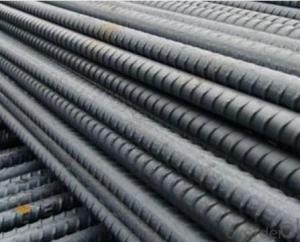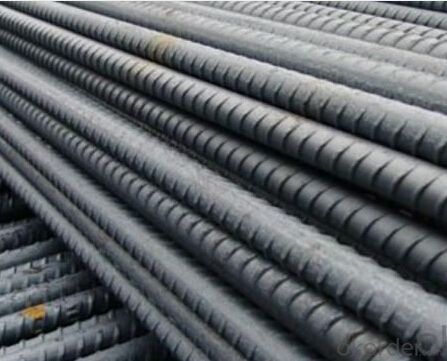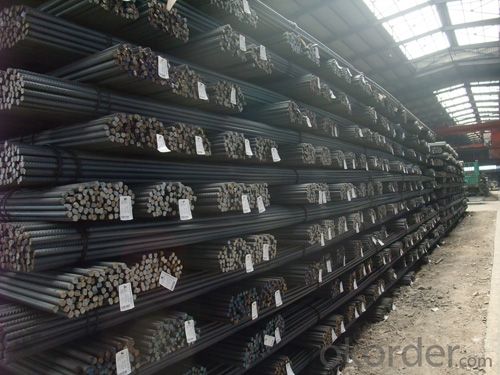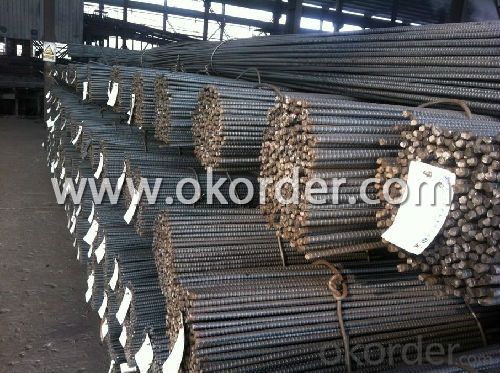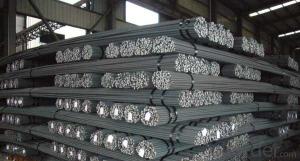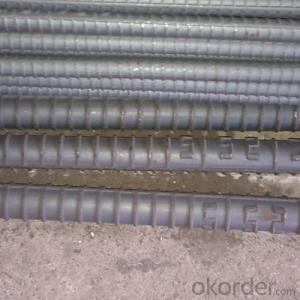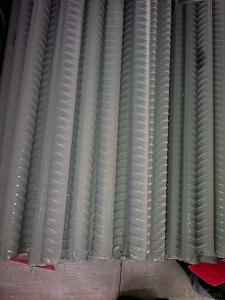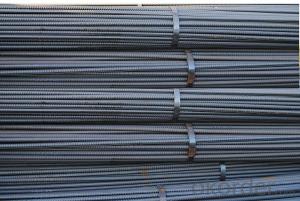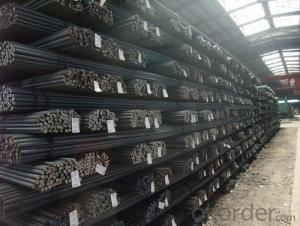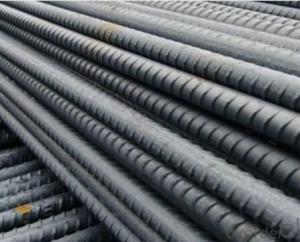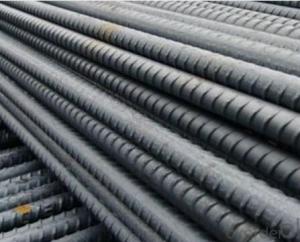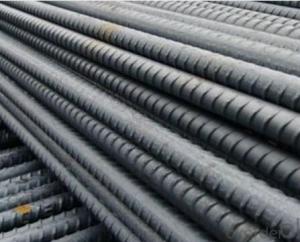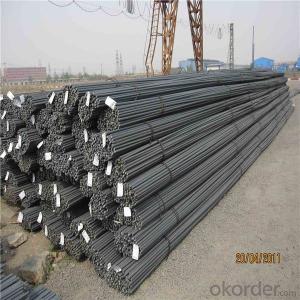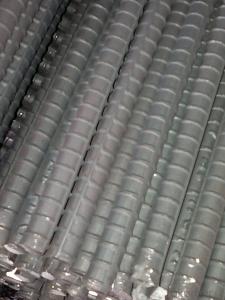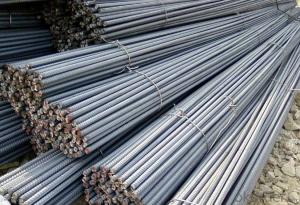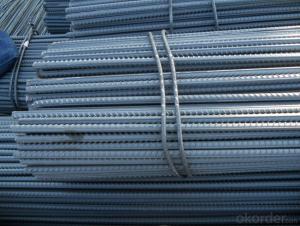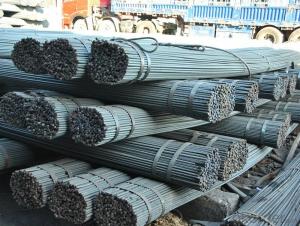ASTM STANDARD HIGH QUALITY HOT ROLLED STEEL REBAR
- Loading Port:
- Tianjin
- Payment Terms:
- TT OR LC
- Min Order Qty:
- 50 m.t.
- Supply Capability:
- 100000 m.t./month
OKorder Service Pledge
OKorder Financial Service
You Might Also Like
Product Description:
Specifications of Hot Rolled Steel Rebar:
The production process of Steel Rebar
1-Waling beam furnace 2-Roughing rolling group 3-Intermediate rolling train
4-Finishing rolling group 5-Water-cooling device 6-Walking beam cooler
7-Finishing equipment(including the cold scale shear,short feet collection system,
automatic counting device,bundling machine, collect bench)
Usage and Applications of Hot Rolled Steel Rebar:
Deformed bar is widely used in buildings, bridges, roads and other engineering construction. Big to highways, railways, bridges, culverts, tunnels, public facilities such as flood control, dam, small to housing construction, beam, column, wall and the foundation of the plate, deformed bar is an integral structure material. With the development of world economy and the vigorous development of infrastructure construction, real estate, the demand for deformed bar will be larger and larger..
Packaging & Delivery of Hot Rolled Steel Rebar:
Packaging Detail: products are packed in bundle and then shipped by container or bulk vessel, deformed bar is usually naked strapping delivery, when storing, please pay attention to moisture proof. The performance of rust will produce adverse effect.
Each bundle weight: 2-3MT, or as required
Payment terms: TT payment in advance or Irrevocable LC at sight.
Trade terms :FOB, CFR, CIF
Label:to be specified by customer, generally, each bundle has 1-2 labels
Note:
1. Our products are produced according to national standard (GB), if not, supply according to national standards (GB) or agreement as customer required.
2. Other Grade and Standard Deformed Steel Bar we can supply:
Grade: GR40/GR60, G460B/B500A/B500B/B500C,BST500S
Standard: ASTM, BS, DIN
The Minimum Order Quantity of these products is high, and need to be confirmed.
3. We can not only supply Deformed Steel Bar; if you need anything about building materials, please contact us for further information.
4. Please send us your detail specifications when inquire. We will reply to you as soon as possible. We sincerely hope we can establish a long stable business relationship.
- Q: Can steel rebars be used in the construction of underground parking facilities?
- Yes, steel rebars can be used in the construction of underground parking facilities. Steel rebars are commonly used in reinforced concrete structures, including underground parking facilities, to provide the necessary strength and structural support. The use of steel rebars helps to enhance the durability and load-bearing capacity of the structure, making it suitable for underground parking facilities that require strong foundations and resistance to potential structural stresses.
- Q: Are there any limitations on the length of steel rebars?
- There are limitations on the length of steel rebars, which are typically set by industry standards and guidelines. These limitations are mainly determined by practical and logistical factors. One limitation is related to transportation and handling of rebars. Steel rebars are typically manufactured in long lengths, often up to 60 feet (18 meters) or more. However, due to the weight and stiffness of steel rebars, it becomes challenging to transport and maneuver such long lengths. Therefore, rebars are often cut into shorter lengths for ease of transportation and handling on construction sites. Another limitation is related to the structural integrity of the rebars. Longer rebars may be more prone to bending, warping, or sagging, which can compromise their effectiveness in reinforcing concrete structures. To ensure structural integrity, rebars are often limited to specific lengths based on the specific application and design requirements. Additionally, there may be limitations imposed by local building codes and regulations. These codes and regulations aim to ensure the safety and durability of structures. They may specify the maximum length of steel rebars that can be used in different construction applications to meet the required standards and ensure the structural integrity of the building. In summary, while steel rebars can be manufactured in long lengths, practical considerations, structural integrity, and local regulations often impose limitations on their length. These limitations are in place to ensure the efficient handling and transportation of rebars, maintain their structural integrity, and comply with building codes and regulations.
- Q: How are steel rebars installed in construction projects?
- Steel rebars are installed in construction projects as a vital component of reinforced concrete structures. The process of installing steel rebars involves a series of steps. Firstly, the construction plans and specifications are reviewed to determine the required size, length, and placement of the rebars. This information is crucial to ensure the rebars provide the necessary strength and support to the structure. Next, the rebars are cut and shaped according to the specifications. This is typically done using specialized tools such as rebar cutters and benders. The rebars are usually supplied in long lengths and are cut to the required size on-site. Once the rebars are prepared, they are positioned and secured in the formwork or molds that will shape the concrete. This is done by placing the rebars at the desired locations and using wire or rebar ties to hold them in place. The ties are typically twisted around the rebars using pliers or a similar tool. This ensures that the rebars remain in their correct positions during the pouring and curing of the concrete. During the concrete pouring phase, the rebars are carefully positioned to ensure they are evenly distributed and adequately spaced. This is important for providing structural integrity and preventing the occurrence of weak spots in the concrete. After the concrete is poured, it is left to cure and harden. During this time, the rebars become embedded within the concrete, forming a strong bond. This bond creates a reinforced concrete structure that is capable of withstanding various loads and forces. In summary, the installation of steel rebars in construction projects involves cutting and shaping the rebars, positioning them correctly within the formwork, and securing them in place using ties. This process is crucial for creating reinforced concrete structures that are strong and durable.
- Q: What is the difference between the actual weight and the actual weight of the steel thread?
- As for the calculation of it, big steel mills are GB, generally within 70-80 thousandths of the difference, a little less than 30-40 kilograms of good, bad 80-90 kilograms. Science is the brand superscript weight, the actual weight is weighing several pounds, no difference multiplied by the coefficient, the factory difference is not the same, for example, Xilin Iron and steel will be multiplied by (1-0.06 or 0.07)
- Q: What are the typical costs associated with using steel rebars in a construction project?
- The typical costs associated with using steel rebars in a construction project can vary depending on factors such as the quantity and size of rebars required, market conditions, and location. However, in general, the costs can include the purchase price of the rebars themselves, transportation and delivery expenses, installation labor costs, and any additional fees or taxes. It is advisable to consult with suppliers and contractors to get accurate cost estimates for a specific construction project.
- Q: What is the lifespan of steel rebars?
- The longevity of steel rebars can differ based on various elements including the steel's quality, environmental circumstances, and maintenance methods. In general, steel rebars possess an extensive lifespan and are specifically engineered to provide structural reinforcement for numerous years. When properly installed and maintained, steel rebars can endure for several decades or even surpass a century. Nevertheless, factors such as exposure to corrosive surroundings or inadequate maintenance can considerably diminish their lifespan. Routine examinations, protective coatings, and appropriate drainage systems can aid in prolonging the lifespan of steel rebars and guaranteeing their long-lasting durability.
- Q: What is the maximum spacing allowed between steel rebars in concrete slabs?
- The maximum spacing allowed between steel rebars in concrete slabs typically depends on various factors such as the thickness of the slab, the load it will bear, and the design requirements. However, as a general guideline, the maximum spacing is often specified to be around 3 times the slab thickness or 18 inches (whichever is less) to ensure proper reinforcement and structural integrity.
- Q: What are the different sizes of steel rebars available in the market?
- The sizes of steel rebars available in the market vary depending on the specific needs and requirements of construction projects. Generally, steel rebars come in a range of diameters, commonly ranging from 6mm to 40mm. These sizes are designated by the nominal diameter of the rebar. The most commonly used sizes of steel rebars in the market are 6mm, 8mm, 10mm, 12mm, 16mm, 20mm, 25mm, 32mm, and 40mm. These sizes are widely used in various construction applications and are readily available in most hardware stores. The choice of rebar size depends on the structural design, the load-bearing capacity required, and the specific construction project. Smaller diameter rebars, such as 6mm or 8mm, are commonly used in light construction projects or where lesser load-bearing capacity is needed. On the other hand, larger diameter rebars, such as 25mm or 32mm, are often used in heavy-duty construction projects or structures requiring higher load-bearing capacity. It is important to consult with structural engineers or construction professionals to determine the appropriate rebar size for a specific project, as they can provide guidance based on the design requirements and structural calculations.
- Q: Can steel rebars be used in the construction of sports stadiums or arenas?
- Certainly, the utilization of steel rebars in the construction of sports stadiums or arenas is a viable option. These rebars are frequently employed as reinforcement in concrete structures due to their impressive tensile strength and durability. Their suitability for extensive projects, such as sports stadiums, is evident. By providing extra support and stability, the rebars enable the concrete to withstand the immense loads and forces that occur during events in stadiums and arenas. Moreover, the versatility of steel rebars allows for effortless shaping and bending to match the specific design requirements and needs of the structure, making them an adaptable choice in construction endeavors.
- Q: How are steel rebars recycled after demolition?
- Steel rebars can be recycled after demolition by collecting them from the demolished structures, cleaning and sorting them, then sending them to a recycling facility. At the facility, the rebars are melted down in furnaces and transformed into new steel products, reducing the need for virgin steel production and conserving valuable resources.
Send your message to us
ASTM STANDARD HIGH QUALITY HOT ROLLED STEEL REBAR
- Loading Port:
- Tianjin
- Payment Terms:
- TT OR LC
- Min Order Qty:
- 50 m.t.
- Supply Capability:
- 100000 m.t./month
OKorder Service Pledge
OKorder Financial Service
Similar products
Hot products
Hot Searches
Related keywords
